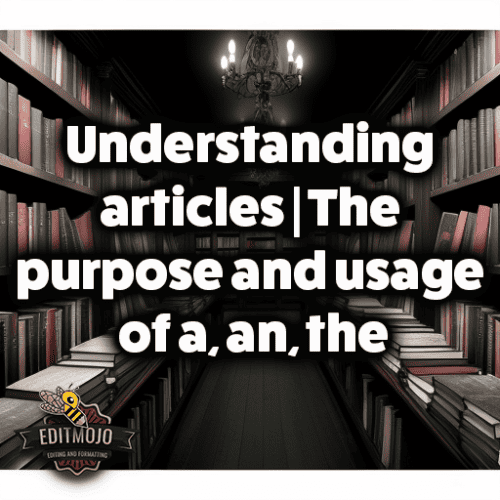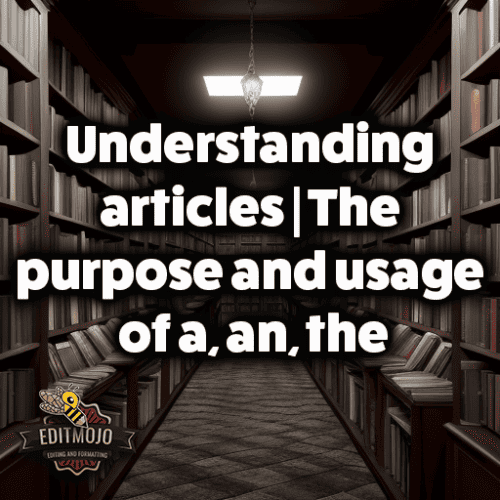Understanding articles | The purpose and usage of a, an, the
Understanding articles | The purpose and usage of a, an, the. An old English proverb says, “Even a small star shines in the darkness.” Similarly, in the galaxy of English grammar, articles—though small—shine with their importance. They are the unsung heroes that give sentences context and specificity. Articles— ‘a’, ‘an’, and ‘the’— may seem trivial at first glance, but they can drastically change the meaning of a sentence. Let’s start this journey into the world of English articles!
Key Takeaways
| Key Point | Explanation | |
|---|---|---|
| 1. | Role of Articles | Articles give context and specificity to the nouns they precede. |
| 2. | ‘A’ and ‘An’ | ‘A’ and ‘An’ are indefinite articles used to introduce non-specific nouns to the conversation. ‘A’ is used before consonant sounds and ‘An’ before vowel sounds. |
| 3. | ‘The’ | ‘The’ is a definite article used to refer to specific or known nouns. |
| 4. | Dialect Variations | Usage of articles can vary between English dialects and regions. |
| 5. | Importance in Professional Writing | Correct usage of articles is crucial in professional settings for clear and precise communication. |
| 6. | Learning and Teaching Strategies | Mastery of articles comes through practice and varied exposure to the language. |
The Role of Articles in English Language (grammar)
Articles are the quiet workers of English language. They sit before a noun, signifying its definiteness or indefiniteness, and thereby altering its meaning. For instance, consider the difference between “I saw a man” and “I saw the man.” The first sentence refers to any man, while the second specifies a particular man.
Their role becomes even more evident when we encounter a sentence like “I love dog.” Confusing, isn’t it? That’s because the noun “dog” is missing its article, leading us to wonder, “Which dog? Any dog? Every dog?” Articles rescue us from such confusion!

Introduction to Indefinite Articles: ‘A’ and ‘An’
Indefinite articles, as their name suggests, introduce something not specifically known to the person you’re communicating with. They’re the mysterious introductions of unknown or first-time-mentioned nouns. They are ‘a’ and ‘an’.
For instance, consider “I saw a dog in the park”. Here, ‘a’ introduces the dog as a new information to the listener.
Understanding ‘A’
‘A’ is like a newborn baby, bringing something new into the conversation. It’s used before words that start with a consonant sound. For instance, “a dog,” “a car,” or “a big apple.”
Remember, it’s about the sound, not the letter. Therefore, we say “a university” (which sounds like ‘yu-niversity’) and not “an university.”
Understanding ‘An’
‘An’ is the twin of ‘a’, used before words that start with a vowel sound. “An apple,” “an hour,” or “an honest person.” Again, note the emphasis on sound rather than letter. Hence, “an hour” is correct, not “a hour,” because ‘hour’ begins with a vowel sound.

Differences Between ‘A’ and ‘An’
Though ‘a’ and ‘an’ are twins, they’re not identical! They differentiate based on the sound that follows them. ‘A’ prefers to hang out with consonant sounds, while ‘an’ is a friend of vowel sounds. When choosing between ‘a’ and ‘an’, let your ears guide you!
Introduction to Definite Article: ‘The’
While ‘a’ and ‘an’ are a bit mysterious, introducing something new or undefined, ‘the’ is all about precision. It points directly to something specific known to everyone in the conversation.
Consider this: “The dog that bit me was huge.” Here, ‘the’ tells us that we’re talking about a specific dog—the one that bit the speaker.
Understanding ‘The’
‘The’ is used before singular and plural nouns when the noun is specific. For instance, “The apples I bought were delicious” refers to specific apples—the ones the speaker bought.
‘The’ is versatile—it doesn’t worry about vowel or consonant sounds. It’s equally comfortable in sentences like “the apple,” “the dog,” or “the hour.”
Differences Between ‘A’, ‘An’, and ‘The’
Each article sets a different scene. ‘A’ and ‘an’ introduce a character onto the stage of conversation, while ‘the’ shines a spotlight on a specific character already known to the audience.
Consider a detective novel. When the author first introduces a character, they might say, “A man walked into the room.” As the plot thickens, and the man becomes known to us, the author says, “The man pulled out a letter.”

Articles in English Dialects and Accents
Language is as diverse as the people who speak it. The way we use articles can reveal where we’re from or even our profession. For example, in some regions, you might hear “I’m going to hospital,” while others would say “I’m going to the hospital.” Both are correct—it’s just a matter of dialect!
Articles in Professional Writing
In professional settings, the correct use of articles is crucial. It can be the difference between “a report” (any report) and “the report” (the specific one we’re discussing). Misusing articles can lead to confusion, or even major errors, especially in fields like law or medicine where precision is paramount.
Learning and Teaching Strategies for Articles
Mastering the use of articles takes time and practice. For English learners, listening to native speakers and reading diverse texts can be beneficial. Teachers, on the other hand, can help by creating activities that focus on article use in varied and meaningful contexts.
Conclusion
In the vast universe of English grammar, the humble articles ‘a’, ‘an’, and ‘the’ might seem like small stars. However, their light is vital in illuminating meaning, bringing clarity to our sentences and helping us communicate more effectively. Keep exploring these stars, and soon, they’ll guide your way through even the most complex English sentences.
Quiz and Additional Resources
Ready to test your understanding of articles? Try out this quiz!
For further reading, the Purdue Online Writing Lab offers excellent resources. Remember, the key to mastering articles, like any grammar point, is practice and patience. Keep exploring, keep learning, and keep shining, grammar stars!
There you have it! Understanding the purpose and usage of articles is the first step towards becoming an expert in English grammar. So next time when you see ‘a’, ‘an’ or ‘the’, give them a little nod of appreciation—they’re the tiny stars that light up the sky of English language!
Top Five Questions and Answers
| Questions | Answers | |
|---|---|---|
| 1. | When do we use ‘a’ and ‘an’? | ‘A’ and ‘An’ are used to introduce non-specific or unknown nouns. ‘A’ is used before consonant sounds and ‘An’ before vowel sounds. |
| 2. | When do we use ‘the’? | ‘The’ is used to refer to specific or known nouns. |
| 3. | Can ‘a’ and ‘an’ be used interchangeably? | No, ‘a’ is used before words that start with a consonant sound and ‘an’ before words that start with a vowel sound. |
| 4. | How can one improve the usage of articles? | Improvement comes with practice. Reading diverse texts, listening to native speakers, and practicing with grammar exercises can help. |
| 5. | How important is the use of articles in professional writing? | In professional settings, the correct use of articles is crucial for clear and precise communication. Misusing articles can lead to confusion or even major errors. |
Top Seven Resources for Further Reading
| Resource | Keywords | |
|---|---|---|
| 1. | Purdue Online Writing Lab | Articles, Grammar Rules |
| 2. | BBC Learning English – Articles | Article Usage, BBC, Learning English |
| 3. | British Council – English Grammar | English Grammar, Articles, British Council |
| 4. | Grammarly Blog – When to Use Articles | Article Usage, Grammarly |
| 5. | Khan Academy – Using Articles | Articles, Grammar Practice, Khan Academy |
| 6. | EngVid – Definite and Indefinite Articles | ‘A’, ‘An’, ‘The’, EngVid |
| 7. | Cambridge Dictionary – Grammar Tutorial | Cambridge Dictionary, English Grammar, Determiners |
